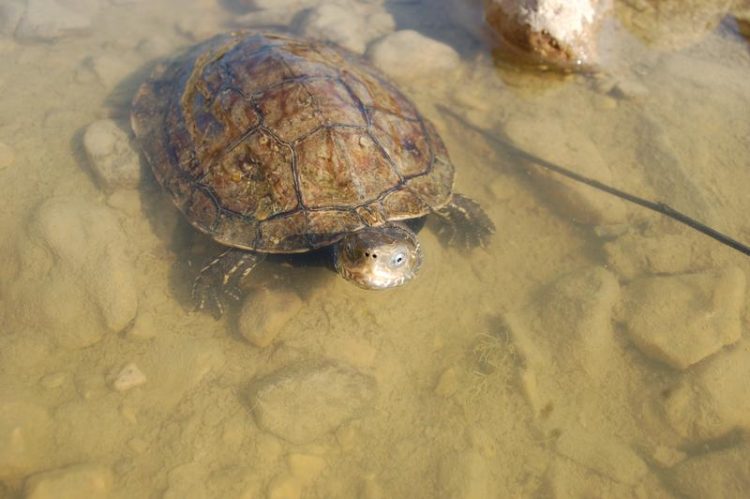My bonnie is over the ocean – Freshwater turtle crosses the Aegean Sea

Mauremys rivulata – here in its natural habitat on the bank of a stream © M. Vamberger
Mauremys rivulata is a turtle, no more than 24 centimetres in size, which is widely distributed in lakes and streams in the region of the Eastern Mediterranean, from southeast Europe and Greece to western Turkey and as far as Lebanon, Israel, Syria and the islands of Crete and Cyprus.
The wide range of the species led the research team of Prof Dr Uwe Fritz, Managing Director at Senckenberg Dresden to study this species of turtle genetically.
“Because of the many geographical barriers in the range of this freshwater turtle – especially the Aegean Sea – we assumed that there would be many genetically different populations. This was based on the consideration that there was no gene flow between the isolated distribution patches, as the sea divides the populations,” says Fritz.
The story that emerged, however, was quite a different one: Using different genetic methods, the scientists examined 340 turtle samples from a total of 63 localities across the entire region of distribution. “The astonishing thing is that even turtles living at great distances from each other display an almost identical genetic pattern, for instance, in southeast Europe and Asian Turkey” explains Fritz. This means that the turtles must have found a means to exchange their genes across large distances – and indeed over hundreds of kilometres of sea.
But how do the animals manage to live on both sides of the Aegean without developing into an individual species over time? “One idea is that the turtles were brought to the different regions by humans, which meant that the gene pool could mix constantly,” explains Melita Vamberger, lead author of the study, and adds: “Yet in contrast to other turtles, Mauremys rivulata was never popular as food, because these animals stink terribly. There is therefore no obvious reason why these turtles should have been transported in such large numbers.”
Thus, only one other – unexpected – possibility remained for the researchers: “We assume that this freshwater turtle is dispersed across the sea. It is likely that turtles are swept repeatedly from their habitats in coastal swamps into the sea by storms. They can obviously survive for a long time in the sea, long enough until they are washed onto some shoreline somewhere. And this occasional exchange is sufficient!”
In fact, some time ago a Mauremys rivulata was caught on open water near Cyprus, which would support this theory.
And whatever a turtle can do might also be a feasible option for others. “It might well be possible,” says Fritz, “that other turtle species take the route across the sea. For instance, this could also explain the weak genetic structure found throughout the widely distributed and endangered North American diamond terrapin (Malaclemys terrapin)”. This could necessitate rethinking conservation measures for this and other species.
Contact
Prof. Dr. Uwe Fritz
Senckenberg Naturhistorische
Sammlungen Dresden
Tel. +49- 351 – 795841 4326
Uwe.Fritz@senckenberg.de
Melita Vamberger
Senckenberg Naturhistorische
Sammlungen Dresden
Tel. +49- 351 795841 4328
melita.vamberger@senckenberg.de
Judith Jördens
Press Office
Senckenberg Gesellschaft für Naturforschung
Tel. +49- 69 7542 1434
pressestelle@senckenberg.de
Publication
Vamberger, M., Stuckas, H., Ayaz, D., Lymberakis, P., Široký, P. & Fritz, U. (2014). Massive transoceanic gene flow in a freshwater turtle (Testudines: Geoemydidae: Mauremys rivulata). – Zoologica Scripta. DOI: 10.1111/zsc.12055
Media Contact
All latest news from the category: Life Sciences and Chemistry
Articles and reports from the Life Sciences and chemistry area deal with applied and basic research into modern biology, chemistry and human medicine.
Valuable information can be found on a range of life sciences fields including bacteriology, biochemistry, bionics, bioinformatics, biophysics, biotechnology, genetics, geobotany, human biology, marine biology, microbiology, molecular biology, cellular biology, zoology, bioinorganic chemistry, microchemistry and environmental chemistry.
Newest articles

Silicon Carbide Innovation Alliance to drive industrial-scale semiconductor work
Known for its ability to withstand extreme environments and high voltages, silicon carbide (SiC) is a semiconducting material made up of silicon and carbon atoms arranged into crystals that is…

New SPECT/CT technique shows impressive biomarker identification
…offers increased access for prostate cancer patients. A novel SPECT/CT acquisition method can accurately detect radiopharmaceutical biodistribution in a convenient manner for prostate cancer patients, opening the door for more…

How 3D printers can give robots a soft touch
Soft skin coverings and touch sensors have emerged as a promising feature for robots that are both safer and more intuitive for human interaction, but they are expensive and difficult…





















